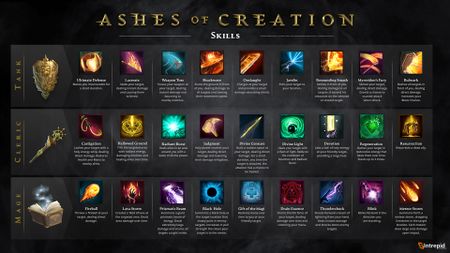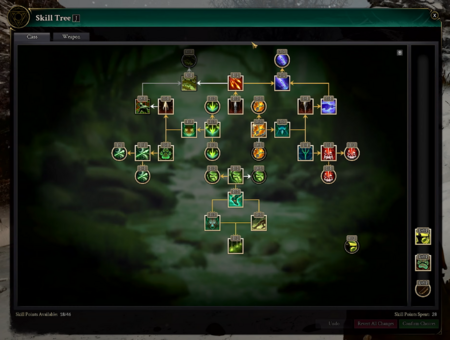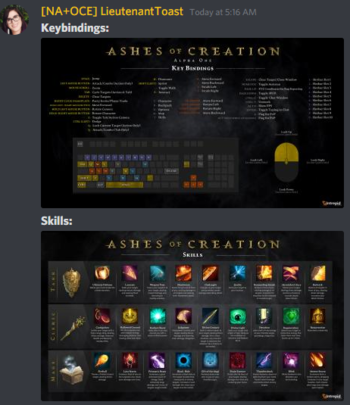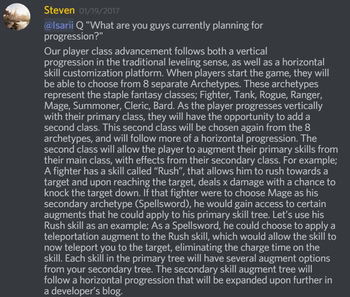角色定位
Ashes of Creation has the traditional trinity of 坦克, DPS (damage dealers) and Support (healer or non-healer) roles.[2][3][4]
- We have our eight base archetypes; and the trinity is a pretty strong influence with regards to the eight base classes. However the area in which we actually begin to play with that line between the trinity is in the secondary classes that you can pick. That's where we begin to blend those spaces and allow people a little bit of influence over their role and whether or not they fit perfectly within a particular category within the trinity.[5] – Steven Sharif
- Although traditional roles are present, players should not feel branded by their primary archetype.[3][4]
- Skill augments available through the class system allow characters to be personalized outside of their primary role.[3][4][5]
- Players can also double down on their archetype choice to strengthen their primary role.[3][4]
平衡
- Balancing in Ashes of Creation is group focused not based on 1v1 combat.[6][7][8]
- 1v1 matchups will have a rock-paper-scissors dynamic, where one class will be superior to another.[6][8]
- There will be match ups in 1v1s where one class will be superior to another; and that application should be a rock-paper-scissors dynamic. We want there to be counter-play between the different classes... Instead it's going to be a group focused balance, where as long as you have the diversity of classes present, that's going to be an equal level playing field. It's going to be very dependent on skill and strategy.[8] – Steven Sharif
- Balance-wise, there's a number of different interactions mechanically that you have within an ability that you can adjust in order to balance its power. The most most common ones are: Cooldown, Mana consumption, Damage done, Effect status conferred, Promotion of that effect status, Range.[9] – Steven Sharif
- Alpha-1 testing was focused on core functionality rather than combat balance.[10]
- Alpha-2 testing will begin to focus on balancing once populations and encounters have been put in place and are deep in testing.[6][11]
- When we move into Alpha 2 and we have a lot of data that's supporting the use of these particular abilities in combat settings, how often they're used, how often they result in death, what the average damage done by this archetype is comparatively to other damage done by different archetypes: All of that data gets logged and all of that data gets queried in order for us to refine the abilities so that they live in the environment we want them to. Now, that's not to mean that we're going to have a perfect balance across the board between the archetypes. Again, we're taking a rock-paper-scissor approach to balance, which means that some archetypes will do better against other archetypes and vice versa; and we're also not creating an environment where we want to have 1v1 balance. We are focused around group balance. Group composition is important.[6] – Steven Sharif
- The sixty four (64) classes are partitioned into eight primary archetypes. Balancing of active skills only relates to these eight primary archetypes.[7][12]
- Certain secondary archetypes are capable of "bridging the gap" between their counterpart.[17]
- Even though augments do radically change the way your active skills provide you abilities, there's still a primary focus on the base archetype itself and not the 64 whole classes.[7] – Steven Sharif
- Certain archetypes are capable of moving the gap between their counterpart per-se. If I am a Tank archetype and a Mage is my counter, I can take a Mage secondary and bridge the divide slightly; and then move my identity that direction ever so slightly.[17] – Steven Sharif
職業技能

If from the eight archetypes whatever you choose as your secondary, you're going to receive a choice of augments that relate to some core ideal of that class. You know like a tank is about controlling the battlefield, is about surviving. The mage is about dealing damage and elements and ability in AoEs. The rogue is going to be about stealth and critical damage. So those augments are going to to play towards those identities.[19] – Steven Sharif
The idea behind the system is that you're skirting the line through these augmentations of your role, right. We have the traditional holy trinity that's present in class designs for MMOs and it's often that those either are not deviated at all or completely deviated from entirely. The augment is to offer a balance between that where you still maintain the semblance of that trinity system while offering the opportunity to customize your play experience towards one of the other angles in the triangle.[20] – Steven Sharif
主要技能 (class abilities) are based on a player's archetype.[21][22]
- A player may choose a secondary archetype when they reach level 25.[23][15] The player can then augment their primary skills with effects from their secondary archetype.[21][23][15][22][24]
- Outside of class-specific skills there may be a subset of universal skills, such as active block and dodge.[25]
- Class skills are not affected by the type of weapon that is equipped.[26]
Class augments
A player may choose a secondary archetype when they reach level 25.[23][15] Each secondary archetype offers four different schools of augmentation.[13][14][15][16] Each augment school affects a primary archetype's skills in different ways.[28]
- For example: A 法師 offers Teleportation and elemental schools of augments. These augments will affect a Fighter's primary skills differently than a Cleric's.[15][28]
- When you reach the class phase, which is around level 25 and you introduce that secondary archetype selection to create your one of 64 classes, then you'll have a number of augments that you'll be able to apply on a per-ability basis; and your core ability kit comes from your primary archetype selection; and those augments will change the look and feel of those abilities; and some will have the affect to create more darker thematic aspects to it. Or just generally different aesthetics to the abilities that represent the secondary [archetype] selection.[23] – Steven Sharif
- The player can then augment their primary skills with effects from their secondary archetype.[29][21][23][15][22]
- The intent behind the augment system is not to provide new active abilities. They're intended to augment existing active abilities that are provided through your primary archetype; and so your secondary archetype selection completes your class selection, of which there's 64 types and you get augment skills that can apply certain attributes and mechanics to your existing active skills. So, if you have certain abilities, like a backstab as a Rogue primary archetype, and you take that healer secondary archetype selection, now the properties of your backstab will still remain the same as an active ability, however it might include things like life steal, or it might include things like susceptible weakness to the target, and reduces their healing because the definition of what those augments are intended to provide based on the archetype selected for the augments is within the schools of magic that live for that archetype: so a Cleric is about balancing life and death and the control of those types of hit points.[29] – Steven Sharif
- Each skill in the primary tree will have several augment options from the secondary tree. This is an example of horizontal progression.[22]
- The progression system for augments is very similar to the class progression system.[30]
- Augments to primary skills can fundamentally change the way the ability works - adapting what the ability once did to incorporate the identity of the secondary archetype/class.[32]
- Augments do not cost skill points.[33] It was previously stated that certain augments will have more expense required on the skill point side.[31]
- There's going to be a certain threshold at which you can no longer augment your active abilities based on the decisions you've augmented previous abilities, so you'll have to pick and choose which ones you want to apply the augments towards.[31] – Steven Sharif
- Secondary archetype augments allow different aesthetics to apply to primary abilities that reflect the secondary archetype selection.[23]
技能點

What you're seeing at a high level here is just what you'd pretty much expect of a traditional skill. We're doing something a little more advanced than just like a bottom up structure, because we're being a little bit more free-form in this iteration. This will obviously see more UI iterations in the future, but you'll see a mix of active and passive abilities here. Actives are indicated by their square shape, while the circular ones are representing passives; and one thing to note as well is that these passives are aiming to be a little more interesting than just like, this ability does more damage now, or it has a lower cooldown. We do have some of those too, but the goal with a lot of these passives in addition to that is to allow people to lean into unique play styles. So you'll notice that some of them are are changing your gameplay in meaningful ways; and that's the direction we want to take um player and character customization as a whole.[38] – Tradd Thompson
Players receive skill points at specific points as they level.[39] These can be used to level up skills (increase their rank) within their active, passive or combat/weapon skill trees.[40][41][42][43]
- Making active skills capable of receiving additional skill point allocations and unlocking additional features so that from a player agency standpoint it's going to be up to you whether or not you want to be more diverse but less depth- wider and not taller, in some of these skill choices. Or if you want to be very very tall, that's going to be something that is up to the player in that regard.[44] – Steven Sharif
- Skill points will accrue at specific XP milestones, such as 1/4, 1/2, 3/4 progress through the level, so as to avoid creating an imbalance with experience debt.[39]
- We do have this concept of experience debt that does accrue and we don't want to create an imbalance between skill points acquired versus experience, so we're going to predicate your skill points acquisition based on benchmarks you reach when leveling through a level. So these are going to be at specific points in the level, like one quarter progress, to half progress, to three quarters progress: you're going to get an influx of skill points and then you'll be able to allocate them into your skill tree.[39] – Steven Sharif
- Skill points can be used to unlock universal skills at the expense of unlocking class-specific skills.[45]
- Respeccing (resetting and reallocating) adventuring skills may require travelling to a specific location rather than being able to be done on-the-fly.[46][47]
- Augments do not cost skill points.[33] It was previously stated that certain augments will have more expense required on the skill point side.[31]
- It will not be possible to max all skills in a skill tree.[43]
- In terms of skill progression, players can choose to go "wide" and get a number of different abilities, or go "deep" into a few specific abilities.[48]
最強裝備
What is considered best-in-slot is based on a character's role and the type of encounter they are facing.[49][50]
- Crafted items are best-in-slot in Ashes of Creation.[51] Previously it was stated that crafted items will be on-par with best-in-slot items.[52]
- Instanced content will contain scripted and difficult boss fights that drop gear, but the gear drops will not be best-in-slot. These can only be found in the open world.[53]
Synergies
Synergies exist between class skills, weapon skills, passive skills, proc effects, and status conditions.[54][55][56][57][58][59][60][61][41][42][62][32][63] These synergies also apply to active skills from other characters.[54][40]
- Q: How much do you intend for those sort of synergy things to be done within one class, one character's kit, versus how much do you intend for them to be working with the other characters, the other archetypes and specializations to promote their things, or to also make sure you don't step on their feet and accidentally promote something they're trying to maximize?
- A: When we talk about status conditions or keyword conditions and the promotion of those effects, there is going to be the bread and butter that each class kid has access to; and when they're creating the type of rotation with their ability system, they're going to want to emphasize those interactions that amplify or promote a particular type of status condition. So they'll have within the kit to their own interactions that they'll be able to leverage. But then in addition to that, they're going to have keyword status effects that help to either promote other classes' keyword status effects, or are the executed promotions of other classes initial status conditions. And when you think about the intent of the design: the intent of the design is that players are servicing themselves from a solo perspective when they want to go out and solo grind and solo experience and fulfill the quests. But when they come together to form a party to encounter group content, or a raid to encounter raid content: that the interconnectivity between those classes synergizes with these keyword promotions and/or effects; and there's a way to execute on that, that is successful and is effective, or a way that's not. And that's the skill ceiling/skill cap that requires interaction and cooperation and synchronization between, because there are limited time windows in which those keywords can get emphasized or executed upon when utilizing the ability.[54] – Steven Sharif
- When you think about it, it's very much a musical endeavor. When you think about a symphony or a concert, those instruments working with eachother to formulate this highly effective and very visceral experience of this music chain. When you accomplish that in combat, it's going to be noticeable; and that's the desire, is let's reward- let's dopamine hit when players are effective in their skill when executing on these ideas.[64] – Steven Sharif
Meta
A goal of Ashes of Creation is to emphasise micro metas that work for specific encounters, and de-emphasize macro metas that work for everything.[49]
- What we're doing with this approach is we're de-emphasizing a macro meta and instead emphasizing a micro meta. And the difference between the macro/micro is that on the micro level you have metas that might form based on each individual type of encounter or experience. And in those senses, yes, there's going to be a most optimal: There's going to be a best in slot. There's going to be whatever that pertains to that particular challenge rating. But there won't we there will not be an overarching meta that says from a macro level, hey, if you got this shit, you're good to go for everything. That's boring, that's unfulfilling, that is not interesting; and it is just something that that dumbifies the experience.[49] – Steven Sharif
- The effectiveness of classes, skills and gear is going to depend on the adversary or the encounter. There will be optimal builds for different challenges and difficulty ratings. This design aims to avoid any obvious meta or "cookie-cutter" builds in Ashes of Creation.[49][65]
- Different challenges are presented dynamically to players based on node progression and destruction. Situations that are based on a rock-paper-scissors design will inspire a horizontal gear chase. These dynamic challenges will change from month to month, causing a shift in demand in the economy as different builds are required by the new content.[65]
- Increasing difficulty ratings inspire more of a traditional vertical power progression that is common in other MMOs.[66][65]
- Oftentimes you just have a very vertical power scale and that determines chase, but when you have a variety of relevance across certain types of adversaries and that variety changes over time because of player activity- and then that affects the economy and the crafter system and who was producing what for what demand- and everything gets shaken up. That's a very fun environment to exist in. It presents a more dynamic situation rather than a quote-unquote cookie-cutter type selection.[65] – Steven Sharif
- The intricacies of how nodes interact with predicates in the world means that it may be possible but difficult to achieve meta server builds.[67]
- Q: Do you have any concerns on players eventually discovering a meta server build with nodes due to players heading to specific nodes and regions because they find that content more enjoyable; and if so how would you go about getting players to shift around the world to break up the meta?
- A: I think it's interesting if players have a concerted effort across a server to interact with one another, learn from their actions, mistakes, successes, and effectuate that on the server. That's interesting, but I don't believe we'll see a meta form. I think that the intricacies are too great when it comes to how predicates are formed in order to elicit world state changes.[67] – Steven Sharif
其他
引用
- ↑ 訪談, 2020-07-29 (49:53).
- ↑ Podcast, 2021-04-11 (13:30).
- ↑ 3.0 3.1 3.2 3.3 Group dynamics blog.
- ↑ 4.0 4.1 4.2 4.3 直播, 2017-05-22 (46:04).
- ↑ 5.0 5.1 訪談, 2018-10-20 (2:40:16).
- ↑ 6.0 6.1 6.2 6.3 直播, 2023-12-19 (1:25:16).
- ↑ 7.0 7.1 7.2 直播, 2020-10-30 (33:26).
- ↑ 8.0 8.1 8.2 Podcast, 2018-04-23 (59:28).
- ↑ 9.0 9.1 直播, 2023-12-19 (1:23:00).
- ↑ 直播, 2021-05-28 (1:13:05).
- ↑ 直播, 2022-12-02 (1:05:51).
- ↑ 12.0 12.1 訪談, 2018-10-20 (2:40:17).
- ↑ 13.0 13.1 Podcast, 2021-09-29 (30:04).
- ↑ 14.0 14.1 直播, 2021-06-25 (1:05:01).
- ↑ 15.0 15.1 15.2 15.3 15.4 15.5 15.6 訪談, 2020-07-18 (1:05:04).
- ↑ 16.0 16.1 直播, 2018-02-09 (41:56).
- ↑ 17.0 17.1 Podcast, 2018-04-23 (1:01:01).
- ↑

- ↑ 直播, 2017-10-16 (1:00:44).
- ↑ 訪談, 2018-08-08 (22:27).
- ↑ 21.0 21.1 21.2 直播, 2023-12-19 (1:20:41).
- ↑ 22.0 22.1 22.2 22.3

- ↑ 23.0 23.1 23.2 23.3 23.4 23.5 直播, 2023-07-28 (1:04:27).
- ↑

- ↑ 直播, 2021-11-19 (50:38).
- ↑ 影片, 2022-09-30 (17:00).
- ↑ 直播, 2021-09-24 (1:18:06).
- ↑ 28.0 28.1 直播, 2019-12-17 (1:13:14).
- ↑ 29.0 29.1 直播, 2024-01-31 (5:00).
- ↑ 直播, 2019-07-26 (1:09:22).
- ↑ 31.0 31.1 31.2 31.3 訪談, 2020-07-18 (1:07:06).
- ↑ 32.0 32.1 February 8, 2019 - Questions and Answers.
- ↑ 33.0 33.1 Forums - Livestream Q&A 2022-08-26.
- ↑

- ↑

- ↑ 訪談, 2018-05-11 (53:15).
- ↑ 直播, 2018-04-8 (PM) (20:45).
- ↑ 38.0 38.1 影片, 2023-12-19 (5:29).
- ↑ 39.0 39.1 39.2 直播, 2023-07-28 (1:03:27).
- ↑ 40.0 40.1 訪談, 2020-07-29 (55:44).
- ↑ 41.0 41.1 訪談, 2020-07-19 (53:59).
- ↑ 42.0 42.1 訪談, 2020-07-18 (1:07:51).
- ↑ 43.0 43.1 直播, 2017-07-28 (19:05).
- ↑ 直播, 2020-08-28 (1:19:24).
- ↑ 直播, 2023-12-19 (1:49:56).
- ↑ 直播, 2023-12-19 (1:46:12).
- ↑ 訪談, 2020-07-29 (54:44).
- ↑ 直播, 2017-11-16 (30:02).
- ↑ 49.0 49.1 49.2 49.3 49.4 訪談, 2023-07-09 (1:43:38).
- ↑ 直播, 2020-05-29 (1:33:11).
- ↑ 直播, 2022-06-30 (1:18:55).
- ↑ 直播, 2017-05-10 (14:45).
- ↑ 直播, 2022-03-31 (1:19:41).
- ↑ 54.0 54.1 54.2 訪談, 2023-07-09 (1:14:09).
- ↑ 直播, 2022-12-02 (56:09).
- ↑ 直播, 2022-06-30 (1:12:38).
- ↑ 直播, 2022-09-30 (53:15).
- ↑ 直播, 2022-09-30 (43:45).
- ↑ 影片, 2022-09-30 (24:49).
- ↑ Podcast, 2021-09-29 (47:57).
- ↑ 訪談, 2021-02-07 (49:18).
- ↑ 直播, 2020-01-30 (1:28:40).
- ↑ 直播, 2018-06-04 (1:11:19).
- ↑ 訪談, 2023-07-09 (1:16:45).
- ↑ 65.0 65.1 65.2 65.3 Podcast, 2021-04-11 (54:35).
- ↑ 訪談, 2023-07-09 (1:40:41).
- ↑ 67.0 67.1 直播, 2023-04-07 (1:15:02).




